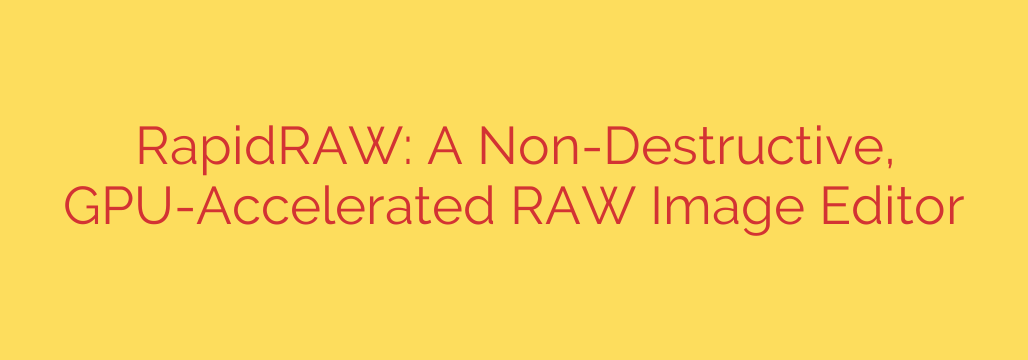
The End of Lag? How GPU-Powered RAW Editors Are Changing the Game
For years, photographers have been caught in a frustrating cycle. Cameras get better, sensors pack in more megapixels, and RAW files become richer with data. Yet, the software we use to edit these massive files often struggles to keep up, leading to stuttering sliders, delayed previews, and a workflow bogged down by waiting. But a fundamental shift in processing power is changing everything.
The next generation of photo editing software is moving beyond the CPU and harnessing the immense power of the Graphics Processing Unit (GPU). This isn’t just a minor speed bump; it’s a revolutionary leap that promises a truly fluid, real-time editing experience.
Why Traditional RAW Editing Is a Bottleneck
To understand why this shift is so significant, we need to look at the data in a RAW file. Unlike a JPEG, a RAW file contains minimally processed data directly from the camera’s sensor. Every time you move a slider—adjusting exposure, recovering shadows, or shifting white balance—the software has to re-interpret and re-render this complex data for the entire image.
Traditionally, this heavy lifting has been handled by the computer’s Central Processing Unit (CPU). While powerful, a CPU is designed for sequential tasks, handling a wide variety of operations one after another. When faced with a 60-megapixel RAW file, this sequential approach can lead to bottlenecks, creating that familiar lag between your adjustment and the result on screen.
The GPU Revolution: Instant, Non-Destructive Editing
This is where the GPU comes in. A modern graphics card is a specialized powerhouse designed for parallel processing. Instead of handling tasks one by one, it can perform thousands of calculations simultaneously. This is ideal for image editing, where the same adjustment needs to be applied to millions of pixels at once.
By offloading this immense workload to the GPU, new software can deliver what photographers have always dreamed of:
- A completely real-time, lag-free experience. Sliders for exposure, contrast, and color respond instantly, even on high-resolution files.
- The ability to see changes as you make them, without waiting for a preview to render.
- A seamless and intuitive workflow that encourages creativity instead of hindering it.
Critically, this performance increase is achieved through a non-destructive editing process. This is the gold standard for professional photography. It means that no matter how many changes you make, your original RAW file remains untouched and pristine. All edits are stored as a set of instructions that are applied on the fly, giving you the freedom to experiment and revert to the original at any time without losing image quality.
Key Benefits of a GPU-Accelerated Workflow
Harnessing the power of the GPU delivers tangible advantages that directly impact a photographer’s efficiency and creative output.
1. Unprecedented Speed and Responsiveness
The most immediate benefit is the elimination of lag. Culling through hundreds of photos, making quick adjustments, and applying complex masks becomes an effortless process. This speed allows you to stay in a creative flow state, focusing on your artistic vision rather than wrestling with your tools.
2. Effortless Handling of Large Files
If you shoot with a modern high-megapixel camera, you know the pain of working with enormous RAW files. GPU acceleration handles these files with ease. The performance that once required creating smaller proxies or waiting for renders is now available instantly on the full-resolution file.
3. The Freedom of Non-Destructive Power
Combining speed with safety is the ultimate goal. You get the instant feedback of editing a simple JPEG with the full data integrity and flexibility of a RAW file. This non-destructive approach ensures that your master files are always safe, providing a professional and worry-free editing environment.
Actionable Tips: Is Your System Ready?
To take full advantage of this new technology, your hardware matters more than ever. The graphics card is no longer just for gaming; it’s a core component for creative professionals.
- Prioritize the GPU: When building or upgrading a computer for photo editing, consider the graphics card to be as important as the CPU and RAM. A modern GPU from NVIDIA or AMD with ample VRAM will make a significant difference.
- Keep Drivers Updated: GPU manufacturers frequently release driver updates that improve performance and stability. Ensure you are running the latest version for your card.
- Don’t Forget Fast Storage: To feed the GPU data quickly, a fast storage drive is essential. An NVMe SSD will ensure that your system can read and write large RAW files without creating a bottleneck.
The era of slow, frustrating RAW editing is coming to an end. By shifting the processing burden to the hardware best suited for the job, GPU-accelerated editors are finally delivering the speed and fluidity that modern photography demands. This leap forward allows photographers to spend less time waiting and more time creating, unlocking a new level of efficiency and artistic freedom.
Source: https://www.linuxlinks.com/rapidraw-non-destructive-gpu-accelerated-raw-image-editor/








